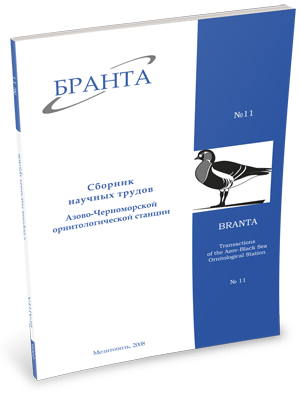
Transactions
of the Azov-Black Sea Ornithological Station



Dynamics and present status of the Cormorant (Phalacrocorax carbo) population in Belarus against a background of the development of problem "Cormorants - fish industry"
I.E. Samusenko
Present paper is based on the materials of studies on the Cormorant ecology, biology and distribution, carried out by the Institute of Zoology of the National Academy of Sciences of Belarus in 2005. An analysis of factors that influence the species numbers is given. These investigations were carried out on task of the Ministry of Natural Resources and Environmental Protection in Belarus and aimed at elaboration of proposals on a reduction of damage from fish-eating birds to fish-farming. For the first time a fact of the Cormorant breeding in Belarus in the 20th century was noted in 1988. Later the species numbers began sharply increasing and it occupied new habitats. Analysis of ring recoveries from the birds, ringed out of Belarus confirms the expansion of the Cormorant from the north-west areas, though the first registrations of vagrant and breeding birds were obtained mainly in the southern regions of Belarus. At the beginning of the 2000s the species continued to increase in numbers, against the prognostication of reduction in population growth rate due to "satiation" of breeding and feeding habitats. Breeding population of the Cormorant in Belarus in 2005 was at level of 2.5-3 thousands of pairs, 24 nesting colonies were known. Probable reason for the further increase of the Cormorant numbers is a state policy of intensification of fish-farming: increase in rate of output of fish production and extension of the area under fish-ponds.
The greatest density and numbers of the Cormorant are observed in the south Belarus - in the regions with maximum density of fish-farms, playing an important role in settlement processes and in growth and support of current numbers of the species. Proportion of breeding pondfish in the Cormorant diet may be significant - up to 92%, though composition of its diet varied with season, distribution of its breeding and feeding sites, depending also on intensity of control measures, carried out within the fish-ponds. Already during the settling of fish-ponds (April- May) the Cormorants, even in relatively small numbers may exert appreciable influence, feeding on fry fish. Numbers of birds foraging in fish-ponds gradually increase within the most fish-farms since May and reach its maximum over late summer - early autumn, when mass fish catch has been carried out in ponds. Several thousands of the Cormorants including birds from adjacent areas form gatherings within the ponds of some fish-farms in August - September, causing even greater damage to fish industry. According to the official data of seven fishfarms over these months there were shot from 7.3 to 12.5% of the total numbers of birds observed within their area in 2005. Since the middle-end October, at the beginning of cold weather period, when fishing has been over within the most fishponds the Cormorants start to leave the bounds of the country.
Struggle against fish-eating birds within the most ponds of the fish-farms in Belarus is carried out mainly by shooting of birds. The system of financial incentives is used in many fish-farms. Some efforts are made to prevent from appearance of the new breeding colonies directly near or at the ponds within the fish-farms; sound and visual methods are used to frighten birds away. Measures aimed to reduce damage from fish-eating birds have been continually modernized. Nevertheless, in most cases results of local and spontaneous efforts are of short duration and don't solve a problem as a whole due to rapid adaptation of birds and "satiation" of free niche with new birds from the other habitats. Furthermore such actions aimed at extermination of the species, making a food competition with people often lead to a great suffering of populations of the other bird species, including rare ones (because of the ecological ignorance of executors) and result in a negative public response.
Read the paper in a PDF file